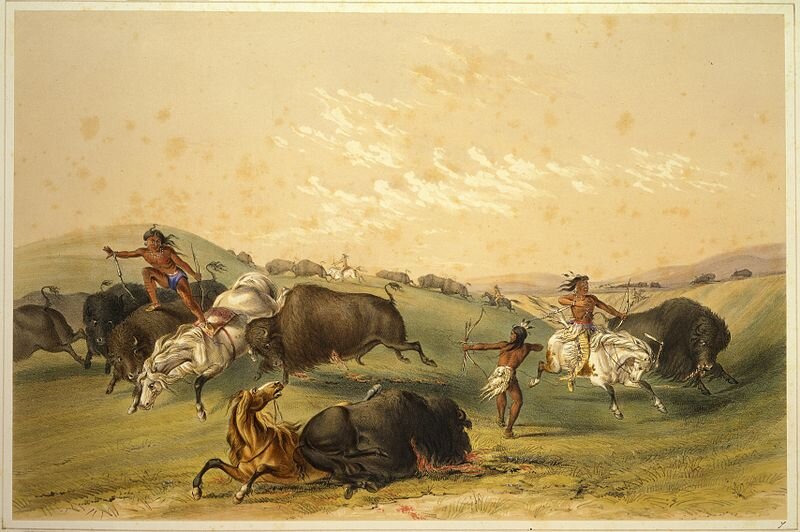Native American Buffalo Hunting - Primary Sources
If you have ever wondered what Native American buffalo hunting looked like you’ve got to read this primary source.
Archeologists speculate that people were hunter-gatherers for most of human history. It is a past that we know very little about for several reasons. First, the hunter-gatherers had no system of writing that we know of, so we can’t learn their stories directly from them. Secondly, almost all of the items they used in their life were natural and have biodegraded over the past 8,000 years. Most of what we have learned about human’s Stone Age history comes from archeological excavations and, more recently, living history experiments. During the early 1800’s however, Americans did get the chance to visit and live with nomadic Native Americans who were still living a relatively Stone Age life. Their stories of Native Americans buffalo hunting offer us a great glimpse of what the majority of humans may have lived like for generations.
One man who visited the American West to document this picturesque scene was Francis Parkman in 1846. Just one year later Parkman penned his historic account of his travels in The Oregon Trail. The purpose of Parkman’s trip west was to see the Native people of the Plains and live with them for a time. After arriving at Fort Laramie, Parkman luckily hooks up with a village of Ogallala and travels with them through the Laramie Mountain range. Not long after he meets up with the village he paints the following scene of what Native American buffalo hunting may have looked like.
“A few moments after, we witnessed a more serious sport. A shaggy buffalo-bull bounded out from a neighboring hollow, and close behind him came a slender Indian boy, riding without stirrups or saddle, and lashing his eager little horse to full speed. Yard after yard he drew closer to his gigantic victim, though the bull, with his short tail erect and his tongue lolling out a foot from his foaming jaws, was straining his unwieldy strength to the utmost. A moment more, and the boy was close alongside. It was our friend the Hail-Storm. He dropped the rein on his horse’s neck, and jerked an arrow like lightning from the quiver at his shoulder.
‘I tell you,’ said Reynal, ‘that in a year’s time that boy will match the best hunter in the village. There, he has given it to him! — and there goes another! You feel well, now, old bull, don’t you, with two arrows stuck in your lights! There, he has given him another! Hear how the Hail-Storm yells when he shoots! Yes, jump at him; try it again, old fellow! You may jump all day before you get your horns into that pony!’
“The bull sprang again and again at his assailant, but the horse kept dodging with wonderful celerity. At length, the bull followed up his attack with a furious rush, and the Hail-Storm was put to flight, the shaggy monster following close behind. The boy clung in his seat like a leech, and secure in the speed of his little pony, looked round towards us and laughed. In a moment he was again alongside the bull, who was now driven to desperation. His eye balls glared through his tangled mane, and the blood flew from his mouth and nostrils. Thus, still battling with each other, the two enemies disappeared over the hill.
“Many of the Indians rode at full gallop towards the spot. We followed at a more moderate pace and soon saw the bull lying dead on the side of the hill. The Indians were gathered around him, and several knives were already at work. These little instruments were plied with such wonderful address that the twisted sinews were cut apart, the ponderous bones fell asunder as if by magic, and in a moment the vast carcass was reduced to a heap of bloody ruins.”
What makes this story even more impressive is that the man known as Hail-Storm is apparently a youth in his mid-teens. Just imagine seeing a teenager careening bareback across the prairie shooting arrows at an angry buffalo while it tried to hook his horse in the ribs. Then, while the buffalo tries to gore him to death, the youth charges off and laughs.
The Parkman description isn’t the only primary source showing Native Americans buffalo hunting. In the 1830s artist, George Catlin made it his mission to record our continent’s indigenous people. While in the Rocky Mountain region Catlin captured many tribes with his art. His paintings depicted Blackfoot, Pawnee, Cheyenne, Crow, and Lakota in addition to others. During his time with the tribes, Catlin also got the chance to see how they hunted. Here are several images showing the action.
Image via wikicommons.
Image via wikicommons.
Image via wikicommons.
When you combine the journal with the pictures you can hopefully develop a sense of what the hunts would have looked like.
Of course, Native people of the plains don’t live like nomadic buffalo hunters anymore. But, they have kept parts of their culture alive even to this day. One such event they participate in each year is the Indian horse race. Watching this modern race will contribute to your understanding of how The Hail-Storm would have looked charging across the plains in 1846. If you’ve never seen an Indian horse race, here is a great video showing how Native Americans have brought their traditions into the 21st century.




